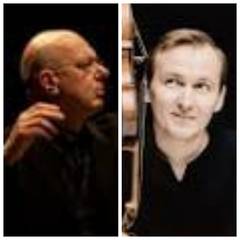|
Back
Boriso-Glebsky’s String Theory of the Galaxies New York
Isaac Stern Auditorium, Carnegie Hall
05/08/2024 -
Grazyna Bacewicz Partita for Orchestra
Joseph Joachim: Variations for Violin and Orchestra
Eugène Ysaÿe: Violin Concerto in D minor
George Enescu: Symphony No. 2, opus 17
Nikita Boriso-Glebsky (Violin)
The Orchestra Now, Leon Botstein (Founder, Conductor)

L. Botstein/N. Boriso-Glebsky
(© Matt Dine for the American Symphony Orchestra/Marco Borggreve)
“Fiddle: An instrument to tickle human ears by friction of a horse’s tail on the entrails of a cat.”
Ambrose Bierce, The Devil’s Dictionary
“It is not for nothing that the newly soulful tone of the violin counts among the great innovations of the Age of Descartes.”
Theodor Adorno
In his introductory remarks, Leon Botstein “thanked” the audience for attending a concert of “unfamiliar music”. No insult to the conductor, but an essential reason to go out to a concert hall is to hear, survey, test and widen the old cerebellum with new challenges and unfamiliar sounds.
At any rate, Mr. Botstein, as usual, fulfilled his promise with one totally new composer, two virtuoso composers and one artist whose compositional chops are usually restricted to a couple of wonderful Romanian Rhapsodies.
The orchestra was of course Mr. Botstein’s The Orchestra Now (TŌN), and as always, their youth belied their expertise. Since all the music was new (to this listener), one might have imagined a crisper more acute series of sounds. But everything sounded right enough here.
All four composers were better known as violin virtuosos than composers. Yet if inspiration was varied they all knew their orchestral writing.
Starting with Polish violinist Grazyna Bacewicz, who lived through the revolutionary years of 1909 to 1969. A fiddler until a lengthy illness, she decided, while recovering, that she would switch her artistry to composition. The result was the short but sweet enough Partita.
The 11-minute four-movement work was beautifully crafted work, with circus music, multi‑rhythmic passages and a beautiful flute solo in the slow movement. Ms. Bacewicz, though was in the unenviable position of creating at the same eras with Penderecki, Lutoslawski and Szymanowski among other countrymen. The Partita was fun, comfortable and conducted with appropriate zest.
Like Hilary Hahn two weeks ago, the young Russian violinist Nikita Boriso-Glebsky gave us two demanding works–as well as a forbiddingly rigorous encore. And one of these works was absolutely overwhelming.
Not the first piece by Joseph Joachim. Now Joachim came close to being ghost‑writer, severe editor and amanuensis for several composers, most notably Johannes Brahms. As editor, he was probably unparalleled. Not inventing techniques like Corelli and Paganini. But in broadening their tricks into memorable Late Romantic concertos.
These Variations were new to me. Their virtues were not so much mathematical variations à la Brahms, as varieties of genres. His dolorous opening theme would probably have been called jüdisch by Herr Wagner, his gypsy dance variation would go back to Joachim’s Hungarian other heritage. Add to this some folk songs, three or four symphonic interludes and an ending medley.
Those Variations were executed by Nikita Boriso‑Glebsky, a Russian‑born whiz of tremendous dexterity, tone and an insouciant attitude. More about him later.
The next work was astonishing. The New York City premiere of a recently discovered concerto by Eugène Ysaÿe, the Belgian fiddler who had to have been astonishing. Which leads to my misinformed category of Bad News and Good News. (See penultimate paragraph.)
The bad news is that I had expected a work similar to his avant‑garde futuristic solo sonatas.
The good news is that Ysaÿe had written–and Mr. Boriso‑Glebsky had executed with electrifying energy–a work in the style of Wieniawski and other 1880’s‑style composers. The best news is that, if relatively conservative, this Concerto contained every single violin trick and technique possible–with tenths, triple trills and everything impossible as well.
And this is where the youthful, obviously delighted Mr. Boriso-Glebsky surveyed and passed all the tests with the easiest joy. By the end of the all‑too‑short 17 minutes, standing up to applaud was not a duty but a spontaneity.
As to the composer’s more daring later Sonatas for Solo Violin, Mr. Boriso-Glebsky gave us the A Minor Sonata. Standing alone, letting his transcendental fingers do the dazzling, one made us pray that he comes here soon for a full recital.
A confession. After the intermission, TŌN were to play Enescu’s hour‑long Second Symphony. The composer himself hid it during his lifetime. A good decision. I had previously heard a movement or two on YouTube, and made a similar decision, to leave before the end, preferring Mr. Boriso-Glebsky’s sounds and spirits to whirl through.
Harry Rolnick
|